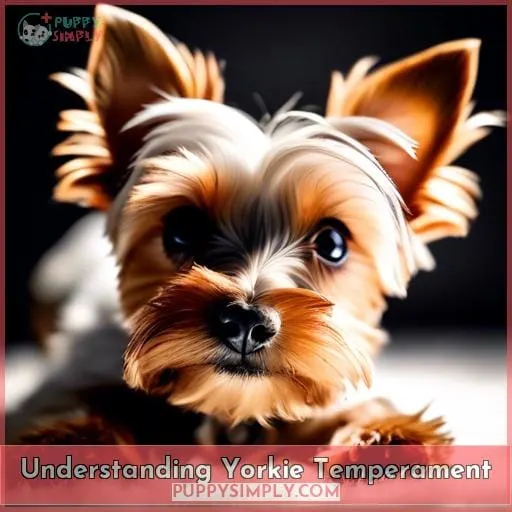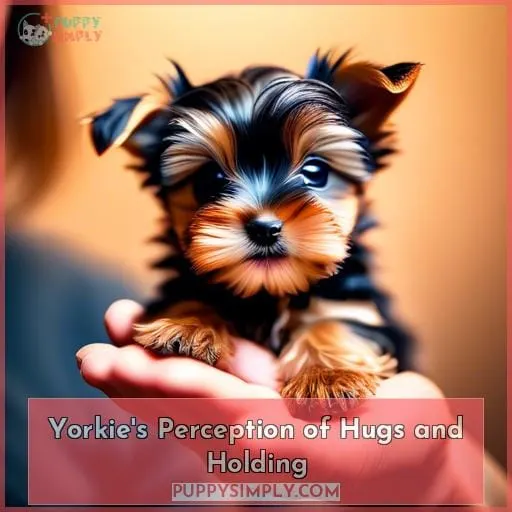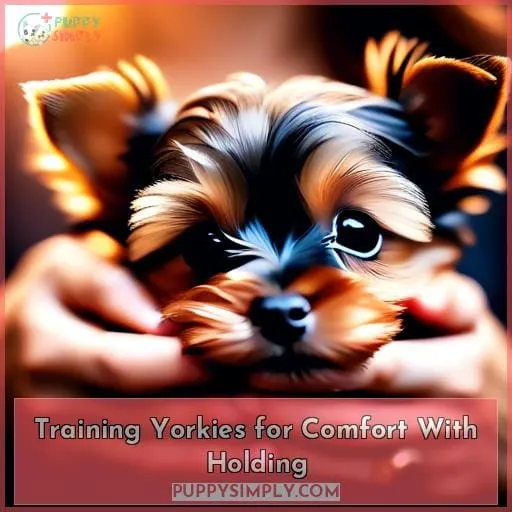This site is supported by our readers. We may earn a commission, at no cost to you, if you purchase through links.

These tiny companions, known for their boundless energy and strong will, often seek closeness with their humans.
Understanding their unique ways of expressing love and comfort is key to nurturing a deep bond.
This article delves into the heart of Yorkie affection needs, offering insights into their desire for physical closeness and how to respect their individual preferences.
Table Of Contents
- Key Takeaways
- Understanding Yorkie Temperament
- Yorkie’s Perception of Hugs and Holding
- Recognizing Yorkie’s Emotional State
- Correct Ways to Pick Up a Yorkie
- Training Yorkies for Comfort With Holding
- Alternatives to Display Affection to Yorkies
- Case Study: Dealing With Independent Yorkies
- Frequently Asked Questions (FAQs)
- How does a Yorkie’s temperament affect their comfort with being held?
- What are some signs that a Yorkie is uncomfortable when being held or hugged?
- How can I train my Yorkie to be more comfortable with being picked up?
- What are some alternative ways to show affection to a Yorkie that doesn’t enjoy being held?
- How can I understand and respect the independence of my Yorkie who doesn’t like to be held?
- Conclusion
Key Takeaways
- Yorkies generally do not like to be held or hugged, as it can make them uncomfortable and stressed.
- Despite their small size and cute appearance, Yorkies have their own preferences and may show discomfort or attempt to escape when hugged or held too tightly.
- Yorkies express affection in unique ways, such as following their owners closely, offering toys, or engaging in playful behavior, rather than enjoying hugs or being held.
- Alternatives to showing affection to Yorkies include engaging in playtime, offering treats, gentle combing, and respecting their independence, allowing them to show affection on their own terms.
Understanding Yorkie Temperament
Understanding your Yorkie’s temperament is key to building a strong bond with them.
Yorkies are known for their independence and high energy, which can sometimes be mistaken for aloofness or disinterest in being held.
However, they’re also very affectionate and can form strong bonds with their owners, showing their love in their own unique ways.
Yorkie’s Independence and Energy
Within the energetic bounds of their independence, Yorkies thrive on interaction with their owners. Despite their small size, they’re full of life and ready for play or a walk at your side.
Their playful energy and self-sufficiency are key aspects of their behavior.
Understanding a Yorkshire terrier’s activity requirements, affection needs, and body language can help you appreciate their energetic personality and independent behavior.
Yorkie’s Interaction With Children
When transitioning from discussing a Yorkie’s independent and energetic nature, it’s important to consider how these traits influence their interactions with children.
You’ve seen how their spirited disposition can make them delightful companions, but when it comes to kids, there’s more to the story.
Yorkies can indeed coexist harmoniously with children, but this relationship hinges on mutual respect and understanding.
Supervising interactions, teaching respect, redirecting behavior, bonding through play, and understanding boundaries are crucial.
Positive reinforcement helps Yorkies associate children with positive experiences, fostering a respectful and loving relationship.
Yorkie’s Affectionate Nature
In terms of affection, you’ll find that Yorkies, despite their independent streak, are known for their intense bonding and love for their human companions.
Affectionate gestures like gentle licks and nuzzles signal their love.
Body language and comfort cues reveal their emotional state.
Bonding behaviors include following you closely.
Emotional responses to your presence, such as a happy bark, show they’re more than just a toy breed; they’re small dogs with big hearts eager to cuddle and share Yorkie behavior.
Yorkie’s Perception of Hugs and Holding
You might wonder if your Yorkie enjoys being held or hugged, given their small and cuddly appearance.
It’s important to understand that while Yorkies, like many dogs, may seek attention and affection, they often don’t appreciate hugs in the same way humans do.
These actions can be uncomfortable and even stressful for them, as dogs typically don’t use this type of physical contact with each other.
It’s crucial to observe your Yorkie’s body language and respect their individual preferences when it comes to showing affection.
Dogs’ Discomfort With Hugs
Despite your best intentions, hugging your Yorkie might not be the gesture of love you think it is. Instead, it can cause them discomfort or stress due to their natural instincts and communication methods.
Canine Communication:
- Licking nose
- Turning stiff
- Yawning, back ears
Hugging Sensitivity:
- Dislikes tight grip
- Confused by hugs
- Seeks to escape
Physical Boundaries:
- Prefers space
- Enjoys gentle touch
- Respects autonomy
Understanding your Yorkie’s body language is key to respecting their physical boundaries and ensuring their comfort.
Dogs’ Different Expression of Love
You might find it surprising, but dogs, including Yorkies, express their love and affection differently than humans do.
Canine communication is unique and often misunderstood due to human expectations.
Here’s how Yorkies might show their love:
- Following you around, indicating their loyalty and desire for your company.
- Offering you their toys, a sign of trust and sharing.
- Engaging in playful behavior, a clear sign of happiness and affection.
- Showering you with tiny licks, their version of kisses and a sign of deep affection.
Recognizing Yorkie’s Emotional State
Understanding your Yorkie’s emotional state is crucial to building a strong bond and ensuring their well-being.
Recognizing signs of happiness, fear, or sadness in your Yorkie can help you respond appropriately to their needs.
Let’s explore how to identify these emotional cues and what they mean for your furry friend:
Happiness: A happy Yorkie will often have a wagging tail, bright eyes, and a relaxed body posture. They may also jump around, play, or bark excitedly.
Fear: A fearful Yorkie may have a tucked tail, dilated pupils, and a tense body posture. They may also cower, hide, or try to run away.
Sadness: A sad Yorkie may have a low tail, dull eyes, and a lethargic body posture. They may also stop eating, playing, or interacting with you.
Signs of a Happy Dog
Recognizing your Yorkie’s happiness involves observing their body language for signs such as:
- A wagging tail
- Relaxed posture
- Bright eyes
Joyful tail wagging, contented ear positions, and relaxed facial expressions signal their comfort.
When you pick up your Yorkie correctly, look for playful body postures indicating they’re at ease, ensuring a bond of trust and affection.
Signs of a Fearful or Stressed Dog
Understanding your Yorkie’s body language is crucial.
Signs like tucked tails, flattened ears, and avoidance behaviors indicate fear or stress.
Recognizing these behavioral cues helps you respond compassionately.
Look for stress indicators such as excessive yawning or licking.
Fear responses might include cowering or shaking.
Anxiety signals can be subtle, so stay attuned to your Yorkie’s unique ways of expressing discomfort.
Signs of a Sad or Upset Dog
Transitioning from the signs of fear or stress, it’s crucial to recognize when a dog, such as a Yorkie, might be feeling sad or upset. Their emotional state can significantly affect their behavior and overall well-being.
Dogs, including Yorkies, may not express sadness in the same ways humans do, but there are telltale signs that can indicate they’re not feeling their best.
These signs include:
- Changes in appetite
- Decreased interest in play or walks
- Increased lethargy
- Seeking isolation by hiding or withdrawing from social interactions
Understanding these signs is essential for providing the appropriate care and support your Yorkie needs to return to a happier state.
Correct Ways to Pick Up a Yorkie
Understanding your Yorkie’s comfort and preferences is crucial when it comes to picking them up.
It’s important to remember that not all Yorkies enjoy being held, and their comfort should always be prioritized.
Let’s discuss the proper techniques for picking up your Yorkie, ensuring their safety and comfort, and how to recognize their signals of discomfort.
Preparing to Pick Up Your Yorkie
So, how do you prepare to pick up your Yorkie in a way that respects their comfort and safety?
- Use preparing techniques like a gentle voice to signal your intention.
- Implement bonding methods by spending quality time together, enhancing trust.
- Apply comfort measures and handling precautions, ensuring your hands support their body securely, avoiding any discomfort.
Proper Handling and Support
In accordance with your dog’s comfort and safety, you should always provide support from beneath, with one hand positioned under the chest and the other cradling the hind legs. Employing proper lifting and supportive handling ensures your Yorkie feels secure.
Gentle embraces, not tight grips, are key to conveying your affection while respecting their space.
Comfort Techniques
- Gentle embraces
- Soft verbal cues
- Positive tone
- Treats as rewards
- Calm approach
Holding Techniques
- Supportive handling
- Proper lifting
- Cradle hind legs
- Hand under chest
- Steady support
Training Yorkies for Comfort With Holding
Training your Yorkie to be comfortable with being held can be a rewarding process.
It’s all about building trust and using positive reinforcement techniques.
Positive Reinforcement Techniques
Once you’ve mastered the correct way to pick up your Yorkie, it’s time to introduce positive reinforcement techniques to help your furry friend become more comfortable with being held.
Offer treats after gentle hugs to foster a connection.
Use praise to reinforce boundaries when respecting their space.
Build trust with consistent, patient training sessions.
Encourage comfort by gradually increasing holding time.
Building Trust and Comfort Over Time
How can you gradually build trust and comfort with your Yorkie to make it more at ease with being held?
Establishing rapport is key.
Encourage bonding through shared activities, fostering connection over time.
Nurturing comfort is a process, not an event.
Steps:
- Shared Activities:
- Encourage bonding through shared activities.
- Foster connection over time.
- Establish a consistent routine.
- Build trust.
- Handle your Yorkie gently.
- Create comfort.
- Use positive reinforcement.
- Strengthen connection.
- Be patient and give your Yorkie time.
- Achieve ease with holding.
Alternatives to Display Affection to Yorkies
Understanding your Yorkie’s unique preferences for affection can help you bond more deeply with your furry friend.
While Yorkies, like many dogs, may not always enjoy being held, there are numerous other ways to show them love and affection.
Let’s explore some alternatives that can make your Yorkie feel loved and cherished, while respecting their comfort and independence.
Non-Physical Ways to Show Love
While you’ve been working on building trust and comfort with your Yorkie through positive reinforcement, it’s also important to explore non-physical ways to express your love and affection.
Engage your furry friend with mental stimulation through interactive toys and enrichment activities.
Incorporate training exercises into playtime, creating bonding activities that foster a deep connection without the need for hugs.
Understanding Yorkie’s Preferred Forms of Affection
Transitioning from non-physical expressions of love, understanding your Yorkie’s preferred forms of affection is key to strengthening your bond.
Bonding through play and recognizing behavioral cues can deepen your emotional connection.
Engage in vocal communication; their response to your tone can be telling.
Socialization benefits their well-being, allowing them to signal their comfort levels and affection preferences clearly.
Case Study: Dealing With Independent Yorkies
If you’ve noticed your Yorkie cherishes its independence and seems less inclined to be held or cuddled, you’re not alone.
It’s essential to respect their personal space and understand that forcing closeness can be counterproductive.
By offering choices and observing their reactions, you can encourage a comfort level with holding and cuddling that suits both of you.
Respecting Yorkie’s Independence
After exploring various ways to show affection to your Yorkie, it’s crucial to understand that respecting their independence is equally important.
Encouraging choice and fostering independence are key.
Honor their preferences and support their autonomy.
This understanding and respect can deepen the bond between you and your furry friend.
Encouraging Comfort With Holding and Cuddling
In dealing with independent Yorkies like Ninja, you’ll find that patience and gradual exposure to gentle holding can increase their comfort with cuddling.
Start with short, positive sessions and include treats to associate holding with rewards.
Use a gentle approach, letting your Yorkie initiate contact when they feel safe.
Build comfort by respecting their space and recognizing signs of stress.
Consistently apply positive reinforcement to foster trust and a loving bond.
Frequently Asked Questions (FAQs)
How does a Yorkie’s temperament affect their comfort with being held?
Yorkies’ feline, affectionate nature may make them enjoy closeness on their terms.
Early positive experiences with handling can foster comfort with being held, but respect their independence and signs of discomfort.
What are some signs that a Yorkie is uncomfortable when being held or hugged?
If your Yorkie:
- Stiffens
- Yawns
- Licks their lips
- Avoids eye contact
- Tries to escape
They’re likely uncomfortable with being held or hugged.
How can I train my Yorkie to be more comfortable with being picked up?
Imagine your Yorkie as a delicate flower, yearning for sunlight but wary of the harsh touch.
To nurture this bond, start by sprinkling seeds of trust with a cue like Boost, paired with a treat, as if watering this budding connection.
Positive reinforcement, akin to sunlight, encourages growth, rewarding desired behaviors with praise or treats.
Gently introduce the concept of being held, as if acclimating the flower to a new pot, ensuring comfort and security at every step.
Patience is your fertilizer, allowing this relationship to bloom into a comfortable embrace.
What are some alternative ways to show affection to a Yorkie that doesn’t enjoy being held?
Show your Yorkie affection by:
- Gently combing its hair.
- Giving belly rubs.
- Offering treats.
Engage in playtime.
Let it sleep with you.
Learn to recognize its emotional state.
Remember to:
- Respect its independence.
- Let it show affection on its terms.
How can I understand and respect the independence of my Yorkie who doesn’t like to be held?
To understand and respect your Yorkie’s independence:
- Observe his body language and reactions.
- Respect his space and don’t force cuddles.
Engage in activities he enjoys:
- Playtime.
- Walks.
Use positive reinforcement to encourage desired behaviors.
Conclusion
Navigating the labyrinth of Yorkie affection is a rewarding journey.
Like deciphering a unique language, understanding whether Yorkies like to be held requires keen observation and respect for their individuality.
Read their emotional cues, handle them with care, and use positive reinforcement to build trust.
If they’re more independent, find non-physical ways to express your love.
Ultimately, it’s about nurturing a bond that respects your Yorkie’s unique affection needs.













